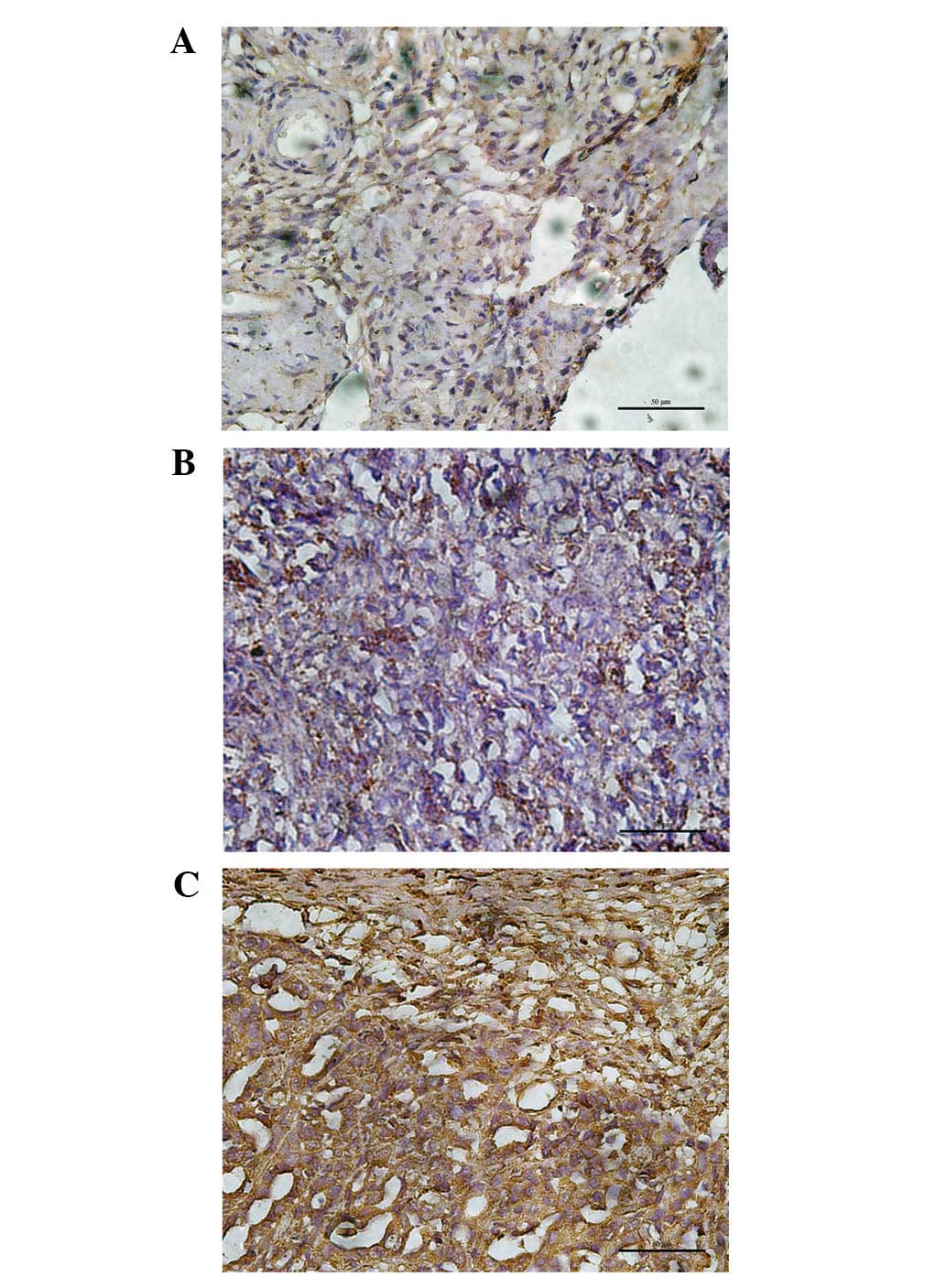Expression of cofilin 1 is positively correlated with the differentiation of human epithelial ovarian cancer
- Authors:
- Jianwei Zhou
- Yinfen Wang
- Jing Fei
- Weijiang Zhang
-
View Affiliations
Affiliations: Department of Gynecology, The Second Affiliated Hospital, School of Medicine, Zhejiang University, Hangzhou, Zhejiang 310009, P.R. China
- Published online on: September 6, 2012 https://doi.org/10.3892/ol.2012.897
-
Pages:
1187-1190
Metrics:
Total
Views: 0 (Spandidos Publications: | PMC Statistics:
)
Metrics:
Total PDF Downloads: 0 (Spandidos Publications: | PMC Statistics:
)
This article is mentioned in:
Abstract
The aim of this study was to examine the correlation between cofilin 1 expression and differentiation of epithelial ovarian cancer in patients. We immunohistochemically analyzed 30 patients with primary ovarian epithelial carcinomas, 14 patients with borderline epithelial ovarian tumors, 13 patients with benign epithelial ovarian tumors and 10 normal ovarian tissues. All ovarian cancer patients received the standard therapy, including staging laparotomy and adjuvant chemotherapy consisting of carboplatin and paclitaxel. Cofilin 1 expression gradually increased in normal ovarian tissues, benign tumors, borderline tumors and carcinomas, respectively, and there were significant differences among them (r=0.94, P<0.05). This suggests a positive correlation between the expression of cofilin 1 and tumor differentiation (r=0.97, P<0.05). The expression of cofilin 1 may predict the development of ovarian cancer and may be involved in the progression of patients with ovarian carcinoma.
View References
|
1.
|
L YangA KlintM LambePredictors of ovarian
cancer survival: a population-based prospective study in SwedenInt
J Cancer123672679200810.1002/ijc.2342918498135
|
|
2.
|
PS KimS DjazayeriR ZeineldinNovel
nanotechnology approaches to diagnosis and therapy of ovarian
cancerGynecol
Oncol120393403201110.1016/j.ygyno.2010.11.02921168905
|
|
3.
|
SS ChenA MichaelSA Butler-ManuelAdvances
in the treatment of ovarian cancer: a potential role of
antiinflammatory phytochemicalsDiscov Med13717201222284780
|
|
4.
|
DS ChiEL EisenhauerO ZivanovicImproved
progression-free and overall survival in advanced ovarian cancer as
a result of a change in surgical paradigmGynecol
Oncol1142631200910.1016/j.ygyno.2009.03.018
|
|
5.
|
AM LutzJK WillmannCW DrescherEarly
diagnosis of ovarian carcinoma: is a solution in
sight?Radiology259329345201110.1148/radiol.1109056321502390
|
|
6.
|
G BalbiA MonteverdeI LandinoMA ManganaroC
FranzeseCytoreductive surgery and ovarian carcinomaActa
Biomed80230233200920578416
|
|
7.
|
BJ MonkRL ColemanChanging the paradigm in
the treatment of platinum-sensitive recurrent ovarian cancer: from
platinum doublets to nonplatinum doublets and adding
antiangiogenesis compoundsInt J Gynecol Cancer19Suppl
2S63S67200910.1111/IGC.0b013e3181c104fa
|
|
8.
|
Q LiJ ZhuF SunL LiuX LiuY YueOncostatin M
promotes proliferation of ovarian cancer cells through signal
transducer and activator of transcription 3Int J Mol
Med281011082011
|
|
9.
|
V LutzU ReuningA KrugerHigh level
synthesis of recombinant soluble urokinase receptor (CD87) by
ovarian cancer cells reduces intraperitoneal tumor growth and
spread in nude miceBiol
Chem382789798200110.1515/bchm.2001.382.5.789
|
|
10.
|
H HallerO MamulaM KrasevicFrequency and
distribution of lymph node metastases in epithelial ovarian
cancerInt J Gynecol Cancer21245250201121721192
|
|
11.
|
S OnoMechanism of depolymerization and
severing of actin filaments and its significance in cytoskeletal
dynamicsInt Rev
Cytol258182200710.1016/S0074-7696(07)58001-017338919
|
|
12.
|
H YamaguchiJ CondeelisRegulation of the
actin cytoskeleton in cancer cell migration and invasionBiochim
Biophys Acta1773642652200710.1016/j.bbamcr.2006.07.00116926057
|
|
13.
|
P HotulainenE PaunolaMK VartiainenP
LappalainenActin-depolymerizing factor and cofilin-1 play
overlapping roles in promoting rapid F-actin depolymerization in
mammalian nonmuscle cellsMol Biol
Cell16649664200510.1091/mbc.E04-07-0555
|
|
14.
|
W WangG MouneimneM SidaniThe activity
status of cofilin is directly related to invasion, intravasation,
and metastasis of mammary tumorsJ Cell
Biol173395404200610.1083/jcb.20051011516651380
|
|
15.
|
RE ShackelfordMM BuiD CoppolaA
HakamOver-expression of nicotinamide phosphoribosyltransferase in
ovarian cancersInt J Clin Exp Pathol3522527201020606733
|
|
16.
|
CM TsangEP LauK DiBerberine inhibits Rho
GTPases and cell migration at low doses but induces G2 arrest and
apoptosis at high doses in human cancer cellsInt J Mol
Med241311382009
|
|
17.
|
D BreitsprecherSA KoestlerI ChizhovCofilin
cooperates with fascin to disassemble filopodial actin filamentsJ
Cell Sci12433053318201110.1242/jcs.08693421940796
|
|
18.
|
H YamaguchiM LorenzS KempiakMolecular
mechanisms of invadopodium formation: the role of the N-WASP-Arp2/3
complex pathway and cofilinJ Cell
Biol168441452200510.1083/jcb.20040707615684033
|
|
19.
|
CT YapTI SimpsonT PrattDJ PriceSK
MaciverThe motility of glioblastoma tumour cells is modulated by
intracellular cofilin expression in a concentration-dependent
mannerCell Motil Cytoskeleton60153165200510.1002/cm.20053
|












